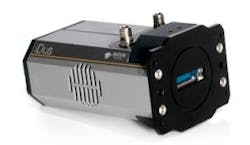Spectroscopy CCD from Andor Technology has peak QE up to 95 percent
The iDus 416 low-dark-current, deep-depletion CCD has higher resolution Raman, photoluminescence, plasmonics, or broadband absorption in the NIR without liquid nitrogen. It has 15 ?m pixels for high resolution spectroscopy and a 30-mm-wide sensor for simultaneous spectral bandpass collection. It has peak QE up to 95% and TE cooling to -95°C.
Andor Technology
Belfast, Northern Ireland
http://www.andor.com
-----
Andor launches new Low Dark-Current Deep-Depletion CCD (LDC-DD); A new standard for low-light NIR Spectroscopy CCDs
Belfast, Northern Ireland - Andor Technology plc (Andor), a world leader in spectroscopy solutions and scientific imaging, today announced the launch of its new back-illuminated, deep-depletion CCD technology on the industry-standard iDus platform. This new technology offers an unsurpassed combination of sensitivity in the near-infrared (NIR) and resolution, opening new possibilities for faster, higher resolution Raman, photoluminescence, plasmonics or broadband absorption without the inconvenient need for Liquid Nitrogen (LN2) use.
Andorâs iDus 416 Low Dark-Current, Deep-Depletion (LDC-DD) technology offers superb dark current performance â over 10 times better than existing deep depletion technologies; and up to 95% quantum efficiency, making it the most sensitive NIR CCD on the market. Thermo-Electric cooling to -95oC ensures that the best signal-to-noise can always be achieved (it is not only dark current that maters for NIR CCD detectors). Andorâs UltravacTM vacuum technologyâs superb track record ensures that the best performance can be extracted from the CCD sensor year-after-year.
The iDus 416 also boasts a unique combination of 15 ?m pixel for high resolution spectroscopy, and a 30 mm wide sensor for superior simultaneous spectral bandpass collection. The fringe-suppression process, ensuring very low optical etaloning, also comes as standard. Its plug-and-play USB2.0 connectivity offers convenient and rapid set up, as well as transportability when connecting to laptops and running in parallel with Andorâs Shamrock spectrograph series.
Antoine Varagnat, Product Specialist for Spectroscopy at Andor, commented that: âThis new exciting CCD technology offers fantastic perspectives for faster optical diagnostic in the field of bio-sample chemical mapping and material analysis, but also the growing field ofin situ and non-invasive medical diagnosis such as early cancer detection or blood monitoring. The iDusâ compact and robust design is also the ideal detector for challenging industrial environment in the process control industry, with the opportunity to increase food, liquids or petrochemical samples screening rates.â
Andor is a world leader in Scientific Imaging, Spectroscopy Solutions and Microscopy Systems. Established in 1989 from Queen's University in Belfast, Northern Ireland, Andor now employs over 350 people in 16 offices worldwide, distributing its portfolio of over 80 products to 10,000 customers in 55 countries.
Andor's digital cameras, designed and manufactured using pioneering techniques developed in-house, allow scientists around the world to measure light down to a single photon and capture events occurring within 1 billionth of a second. This unique capability is helping them push back the boundaries of knowledge in fields as diverse as drug discovery, toxicology analysis, medical diagnosis, food quality testing and solar energy research.
-----
Subscribe now to Laser Focus World magazine; it's free!
